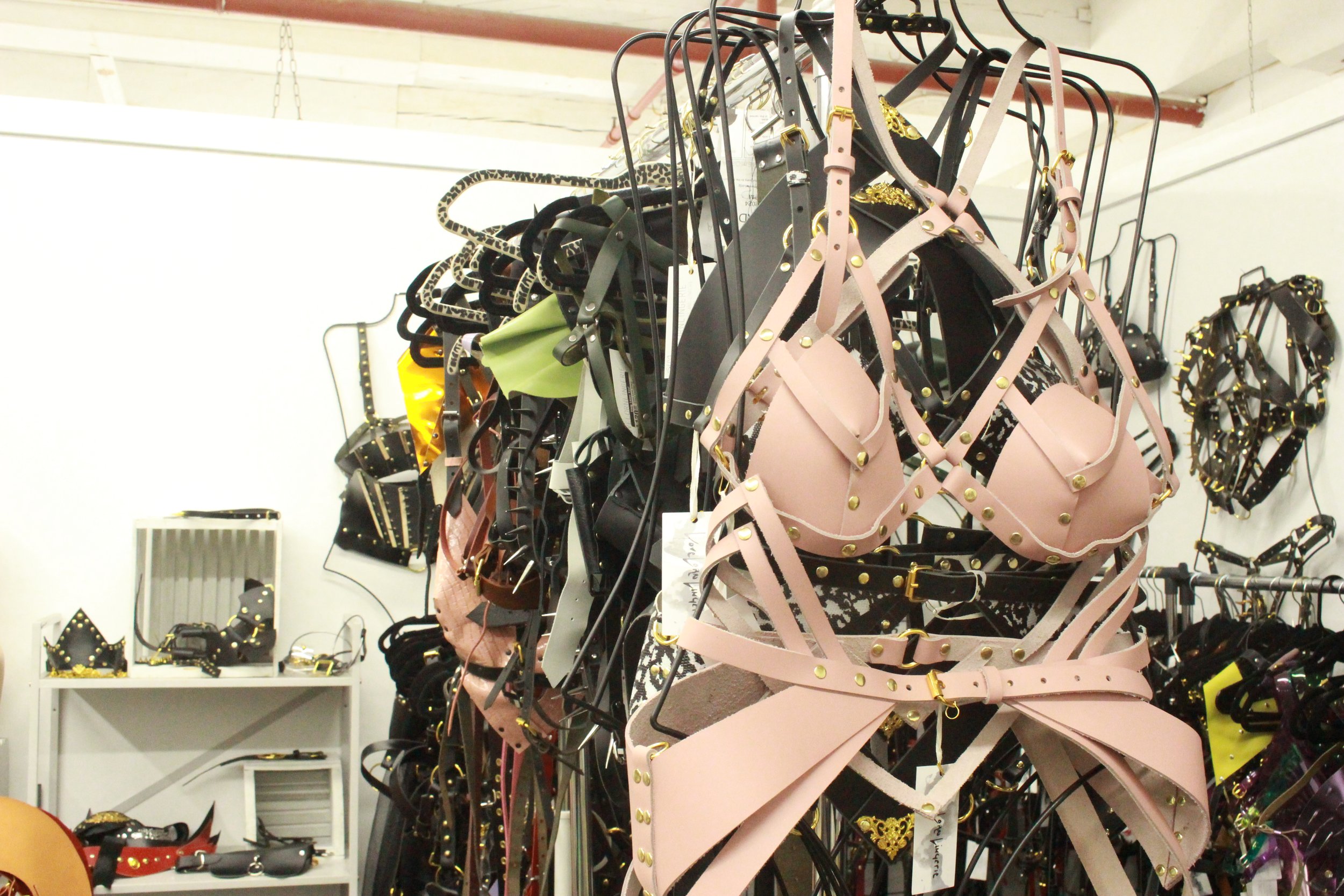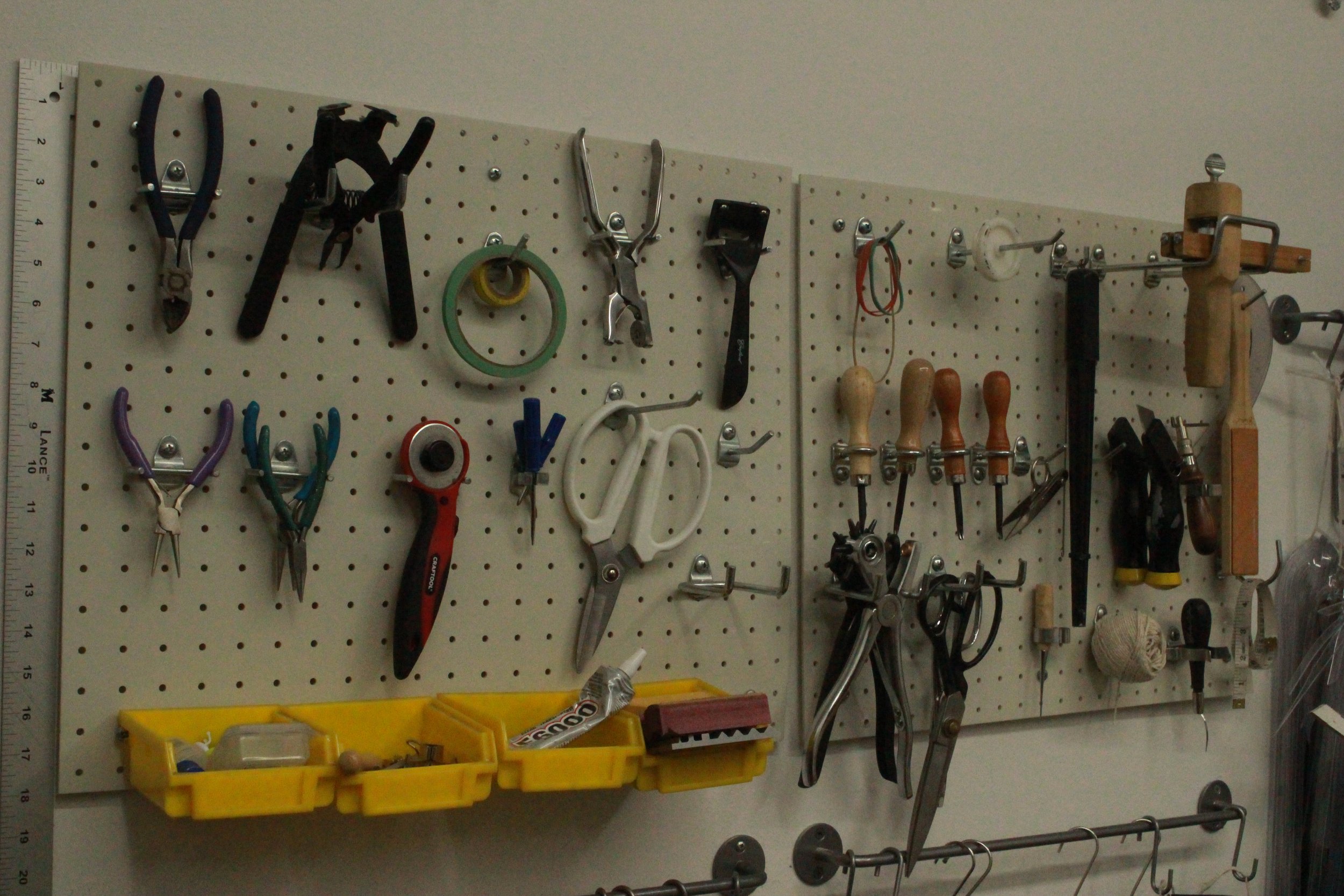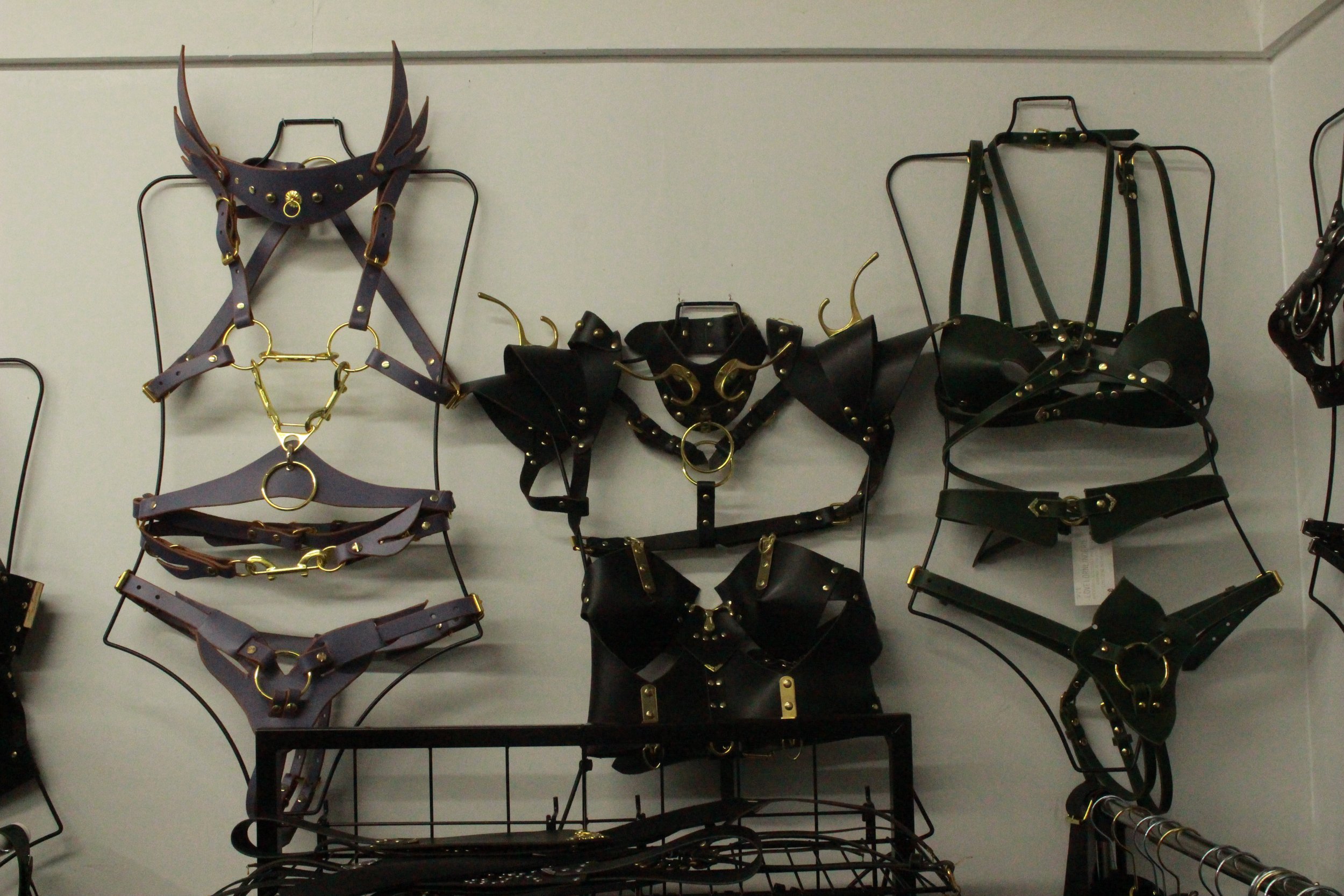— JESSICA —
Jessica in her studio.
Jessica Ding is crafting a world where femme aesthetic and bondage coexist—proving that femininity isn’t soft, it’s weaponized. Surrounded by red, pink, and black hides and studded rivets, she slices through leather like it’s butter—hard-won ease forged through years of grit and grind. Her work—equal parts sugar and snarl—turns the traditionally macho craft of leatherwork into a drenched statement of femme power. In her hands, hyperfemininity isn’t decorative—it’s radical. She doesn’t just cut leather—she carves up clichés, stitching defiance into every leather studded harness.
Starting as a student at Pratt Institute, Jessica got a job in mass market lingerie, she explained that it was not as much of a creative field in which you design, instead doing tech packs and various computer work, rather than having the opportunity to pursue her own creativity within her designs. Until someone happened to hand her a shoebox full of scrap leather. As stated in an interview with me, her response to this box had been, “Oh, okay, well, let me see what I can do with this in my free time…” leading to a harness bra, she had the ability to jump right into her current and budding business, Love Lorn Lingerie. As explained by Jessica, leather is a versatile medium, one that is strong and has structure. Because it didn’t demand stitching or complex seams, the transition into her new craft felt less like starting from scratch and more like slipping into a perfectly broken-in pair of boots—effortless, but only because she knew exactly what she was doing.
Starting with a cup of tea around 7:30 in the morning at her studio in Hoboken, New Jersey, and working on her list of orders to get through, or her own specific pieces for upcoming events, she focuses on creating pieces that allow hyper feminine freedom. Having the ability to work and design out of Hoboken has given Jessica a large, diverse community that she can feel comfortable in, and also design for. The aesthetic and core values behind her brand is very high femme, a lot of ornate details, maintaining its complicated and strappy, but stunning appearance. As Jessica explained, “It does tend to lead more towards the fashion side of BDSM, more costumey pieces,” straying from functional kink gear, highlighting that these statement pieces are purely fashion driven. Drawing inspiration from stories, myths, and media, such as the beloved Sailor Moon, Zena, and Kingdom Hearts, a fantasy inspired aesthetic comes through. Although media is the core of her inspiration, a lot of thought in her designs comes from “how garments feel when they are being worn and how they change when the body moves…I think about, if you wear this belt…where is the cinch on you, and how is that going to change your posture,” thinking intensively about the shape built through material and how it sits allows Jessica to contort and create designs that work with bodies, especially focusing on how others will feel in her work. She mentions that the rhythm of details is an important feature when it comes to designing, that there is a musicality to the composition of physical designs.
As many may think, leatherwork has been associated with masculinity and intense labor, chunky aesthetics, very industrial, while also being very Butch. Within the kink community, leather especially has always been more of a male centered accessory, whereas Jessica brings in designs, made out of a sturdy, hard material, allowing women to embrace delicacy and grace within the hardwearing. To celebrate the strength woven into both femininity and leatherwork, Jessica creates with the female gaze in mind—liberating her designs from the constraints of the male gaze that so often dictates mainstream aesthetics. As she stated, “It is, I think beautiful, and it’s sexy…that’s the point of it.” The positive responses from women and those who identify as femme are particularly meaningful to Jessica, as her designs aim to both empower and captivate those who embrace a more feminine aesthetic. These designs are not for anyone else besides the person wearing them, especially as Jessica says she keeps in mind women and non-binary folk. The rave reviews from women—and anyone who identifies as femme—is what stands as most important. After all, her designs are made to empower those who want to see themselves through a lens of fierce femininity. Contributing to a broader narrative around women’s labor, creativity and independence, stems from a strong femme aesthetic, and carving space for positive reflections of hyperfemininity outside of traditional roles.
For Jessica, empowerment isn't just a buzzword—it's woven into every stitch of her craft and career. She’s all about independence, fearlessness, and doing things her way, unbothered by challenges that pop up along the way. The freedom to choose and create on her own terms is key, and being her own boss means she can champion her beliefs without anyone telling her otherwise. Moments within her process that particularly feel powerful, liberating, and subversive as a woman is having the ability to “create something out of raw materials, to completely transform it.” She goes on to say, “Leather work helps physically, there are moments where you need a lot of force for it,” for her, it’s not just about the force; it’s about getting stronger with every piece, and that’s something she proudly owns.
Photos courtesy of Jessica. (Mantis set and God Killer set)
Her Mantis set and God Killer set stand as pivotal moments in claiming her voice as a woman designer. These pieces blend delicate intricacies with bold, protruding elements, showcasing her versatility. Always considering how her designs interact with the body, she creates pieces that don’t just fit—they demand presence, adding an edgy, aggressive flair to her collections. However perfect a piece may be, an artist is always able to identify imperfections within their craft, which is inevitable, as stated by Jessica. She goes on to mention, “I’ve always really liked the look of perfectly clean lines, perfectly finished pieces…symmetrical pieces, things like that. I spent a lot of time perfecting my craft, but it is a matter of constantly telling myself that it’s fine, this minor wiggle in the edge is not noticeable.”
In the world of non-traditional craft spaces, Jessica’s all about building real connections with her customers—talking them through her work and helping them embrace both her creations and themselves. With lifetime guarantees on every piece, she’s not just about making a sale; she wants her customers to be proud for the long haul. This isn’t mass-produced fluff—it’s handmade with heart and zero cheap labor. Jessica’s all about trust, both in her craft and her business. When it comes to running the show, she believes in the power of positive negotiations—because a business built on solutions, not ego, is a business that thrives. However, Jessica has not faced issues of collaboration with others, such as models and photographers, they have created safe and open spaces, encouraging work. Building a community is the heart of her thriving business—though now and then, she has to sidestep a bit of mansplaining from outsiders who aren’t in her circle of loyal customers and fellow creatives.
Jessica's studio tools.
Jessica mentioned that she receives questions from others often in regard to entering the craft base or manual trade. They ask questions along the lines of, “How do you know about leather internships, or where can I learn these things?” She replies with, “Yes, I did get fashion training from school, which was helpful in garment design, things like that…but I did not know how to do leather. I did not learn that in school, you just have to pick up leather and buy some cheap tools and figure it out.” People may get caught up in thinking about their steps, she advises, “...you just have to do it.” She goes on to mention that craft design has been considered a woman-centered field, which is not to hold a negative connotation, but rather take that to create strength within femininity. She wants her pieces and work within this industry to challenge the male dominated CEOs that bigger companies have within the fetish leather industry. As she explains, “I want my pieces to be able to challenge that, but still keep its core, female driven identity and female led identity...Like, hey! We are still here, and will always be here.” Women within this field are just as good as the male CEOs and will do better, reclaiming their work within this industry.
Next up on her journey is to keep going and growing, working towards creative couture, high fashion, and experimental pieces. Her mantra to keep doing, “Stagnation is death, and you should always be transforming into yourself. You should look back five years from now to your past self and be like ‘Hey, I am very different from that person, and hopefully it’ll be different in a good way, but you know, that can change person to person, but I do think you should always be changing.” Her designs may be delicate, but her mission is anything but—Jessica is reshaping leatherwork with lace, grit, and unapologetic femme energy. Jessica isn’t just reshaping leather—she’s reshaping the space around it. With every studded harness, she’s challenging outdated norms and carving out room for femme expression in a world that still clings to the male gaze. Her work is equal parts art, armor, and attitude, stitched together with pride and a wink. By building community, staying unapologetically herself, and making space for softness with an edge, Jessica proves that empowerment can come wrapped in lace, dipped in leather, and finished, perfectly polished. With leather as her canvas, and femininity as her weapon, Jessica’s rewriting the rules.
Check out Love Lorn Lingerie on instagram!



























